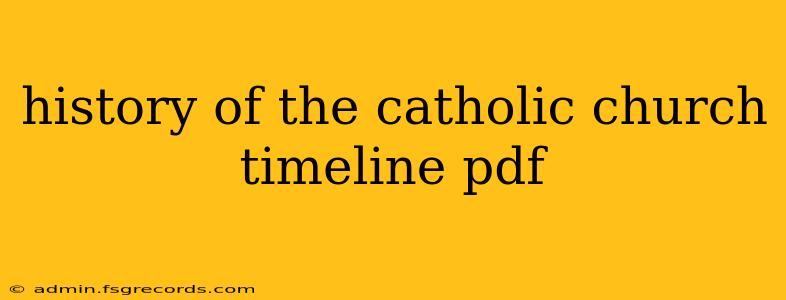A Concise History of the Catholic Church: A Timeline
While a comprehensive history of the Catholic Church is far too vast for a single PDF, this timeline provides key milestones and pivotal eras, offering a framework for deeper exploration. This timeline focuses on major events and shifts in doctrine, organization, and influence. For a more in-depth understanding, consider consulting reputable historical texts and academic resources.
Early Church (c. 30-313 AD):
- c. 30-60 AD: Spread of Christianity throughout the Roman Empire, largely through missionary work. Establishment of early Christian communities and development of core beliefs.
- 64 AD (Traditionally): The Great Fire of Rome and the persecution of Christians under Nero. This marked a significant period of early Christian martyrdom.
- 95-107 AD: Writings of Ignatius of Antioch showcase the growing importance of the Bishop of Rome.
- c. 100-180 AD: The Apostolic Fathers write influential works interpreting Christian doctrine.
- 313 AD: The Edict of Milan granted religious tolerance to Christians within the Roman Empire, marking a significant turning point in the Church's history.
The Rise of the Papacy and Medieval Church (313-1500 AD):
- 380 AD: Christianity becomes the official religion of the Roman Empire under Emperor Theodosius I.
- 410 AD: The sack of Rome by the Visigoths; the decline of the Western Roman Empire. The Church increasingly plays a role in providing social and political stability.
- 451 AD: Council of Chalcedon defines the doctrine of Christ's nature (both fully God and fully man), addressing significant theological disputes.
- 590-604 AD: Papacy of Gregory I (Gregory the Great). He significantly centralized papal authority and expanded Church influence across Europe.
- 1054 AD: The Great Schism formally divides the Eastern Orthodox and Roman Catholic Churches.
- 1073-1085 AD: Papacy of Gregory VII. The Investiture Controversy over the appointment of Church officials intensifies the conflict between the Church and secular rulers.
- 1096-1291 AD: The Crusades, a series of religious wars ostensibly to reclaim the Holy Land. These had a profound impact on European politics, culture, and the Church's image.
- 1215 AD: Fourth Lateran Council establishes key doctrines and practices, including transubstantiation and the importance of confession.
Reformation and Counter-Reformation (1500-1648 AD):
- 1517 AD: Martin Luther posts his Ninety-Five Theses, initiating the Protestant Reformation.
- 1545-1563 AD: Council of Trent responds to the Reformation by reaffirming Catholic doctrines and initiating internal reforms.
- 1534 AD: Henry VIII declares himself Supreme Head of the Church of England, leading to the English Reformation.
- 1540 AD: The Society of Jesus (Jesuits) is founded, playing a significant role in the Counter-Reformation.
Modern Church (1648 AD - Present):
- 1789-1799 AD: The French Revolution and its impact on the Church.
- 1870 AD: First Vatican Council defines papal infallibility.
- 1962-1965 AD: Second Vatican Council (Vatican II) initiates significant reforms in liturgical practices, ecumenical relations, and the Church's engagement with the modern world.
- 2005-2013 AD: Papacy of Benedict XVI. Focus on theological reflection and traditional values.
- 2013-Present: Papacy of Francis. Emphasis on social justice, environmental stewardship, and interfaith dialogue.
Note: This timeline is a highly condensed overview. Each event listed represents a complex historical period deserving of further study. Further research into specific eras, figures, and events is strongly encouraged to gain a more complete understanding of the Catholic Church's rich and multifaceted history. Consulting primary sources, academic journals, and reputable historical accounts is crucial for a thorough and nuanced perspective.

